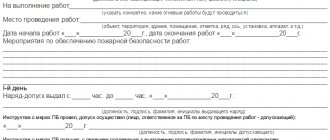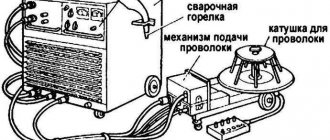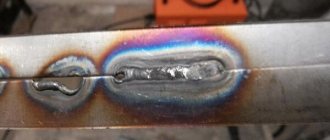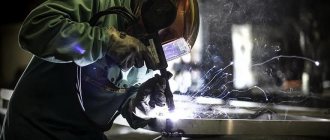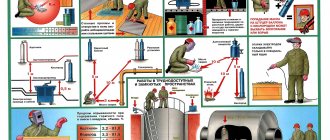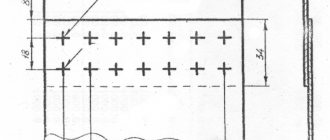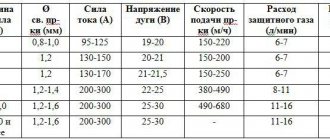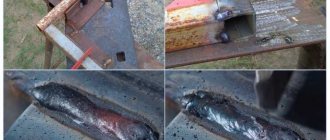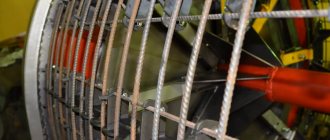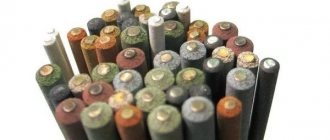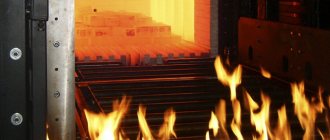A welding engineer is a theorist and practitioner who has deep knowledge and skills in creating and repairing various machines and mechanisms. His work is at the intersection of various disciplines (metallurgy, electronics, materials science and even - in some cases - automation and programming). The profession belongs to the category of “ man-technique ”. By the way, in 2021, the ProfGid career guidance center developed an accurate career guidance test. He himself will tell you which professions are suitable for you, and give an opinion about your personality type and intelligence.
Short description
The working profession of a welder (which is undoubtedly also very important and in demand) should not be confused with the profession of a welding engineer, which requires obtaining a higher education. Such a specialist, most often, is not directly involved in welding work (although he can do this if necessary), but is responsible for management, technological preparation, development and implementation of various projects, monitoring compliance with welding technological standards and safety rules. Its main task is to optimize all processes for the creation and repair of spare parts, structures, machines and mechanisms that are, in one way or another, related to welding.
Job Description for Welding Engineer
Job description of a welding engineer Welding engineer ———————————— (name of organization) APPROVED JOB DESCRIPTION ——————————— (name of position) 00.00.0000 N 000 ——— - ——————— (signature) (initials, surname) Welding engineer 00.00.0000 1.1. A welding engineer is classified as a specialist. 1.2. A person with a higher professional education and work experience in the specialty of at least 3 years is accepted for the position of welding engineer. 1.3. A welding engineer must know: - legislative and regulatory legal acts, administrative and regulatory materials on technological preparation for construction work; — profile, specialization, technological structure of the organization, prospects for its development; — construction technology; — organization and rules of welding work; — main types and methods of welding, their essence, classification and areas of application; — types of welded joints and designations of welded joints on the drawings; — fundamentals of electrical engineering and metallurgy; — types of welding and auxiliary materials, their weldability; — rules for preparing welded joints for welding; — production and technique of welding work by type of object; — fundamentals of the science of strength; — basic principles for calculating welded joints; — methods of mechanization of welding work; — general principles for ensuring the efficiency of assembly and welding work; — types of defects in welded joints, reasons for their formation, methods for their prevention and correction; — methods and methods of quality control in the production of welded structures; — safety rules for assembly and welding work; — technical regulations, technical conditions, standards in force during construction work; — requirements, rules and regulations of Rostechnadzor; — standards and technical conditions for welding work; — basics of labor legislation; — Internal labor regulations; — rules and regulations of labor protection, safety precautions, industrial sanitation and fire protection; - ______________________________________________________________________________. 1.4. A welding engineer in his activities is guided by: - Charter (Regulations) _______________________________________________; (name of organization) - this job description; — _____________________________________________________________________. (other acts and documents directly related to the labor function of a welding engineer) 1.5. The welding engineer reports directly to _____________________________________. (name of manager's position) 1.6. During the absence of a welding engineer (vacation, illness, etc.), his duties are performed by an employee appointed in the prescribed manner, who acquires the corresponding rights and is responsible for failure to perform or improper performance of the duties assigned to him in connection with the replacement. 1.7. ___________________________________________________________________. 2. Functions 2.1. Organization of welding works. 2.2. Quality control of welding work. 3. Job responsibilities The welding engineer performs the following duties: 3.1. Organizes assembly and welding work in accordance with the requirements of regulatory and technical documentation. 3.2. Selects equipment, welding and auxiliary materials, assembly and welding fixtures. 3.3. Instructs welders and carries out technical supervision of assembly and welding work. 3.4. Provides technical supervision over the implementation of assembly and welding work, monitoring compliance with the technological process of welding and assembly. 3.5. Prepares accounting documentation. 3.6. Controls: — the performance of welding equipment and adjusts it to the required parameters; — correctness of preliminary and accompanying heating; — correct storage, preparation and use of welding materials; — compliance with safety regulations when carrying out assembly and welding work; — quality of welded joints. 3.7. Evaluates the cost-effectiveness of assembly and welding work. 3.8. Organizes training and certification of welders. 3.9. Performs other related duties. 3.10. _______________________________________________________________. (other responsibilities) 4. Rights The welding engineer has the right: 4.1. Participate in the discussion of draft decisions of the organization's management. 4.2. In agreement with the immediate supervisor, involve other employees in solving the tasks assigned to him. 4.3. Request and receive necessary information and documents from employees of other structural divisions. 4.4. Participate in discussions of issues related to the duties performed. 4.5. Require the organization's management to provide assistance in the performance of official duties. 4.6. _________________________________________________________________. (other rights) 5. Responsibility 5.1. The welding engineer is held accountable: - for improper performance or failure to fulfill his job duties as provided for in this job description - in the manner established by the current labor legislation of the Russian Federation; — for violation of the Charter (Regulations) of the organization; - for offenses and crimes committed in the course of their activities - in the manner established by the current administrative, criminal and civil legislation of the Russian Federation; - for causing damage to the organization - in the manner established by the current labor legislation of the Russian Federation. 5.2. ___________________________________________________________________. 6. Final provisions 6.1. This job description has been developed on the basis of the Qualification characteristics of the position “Welding Engineer”, approved as part of the “Qualification characteristics of positions for employees of nuclear energy organizations”, approved by Order of the Ministry of Health and Social Development of the Russian Federation dated December 10, 2009 N 977, taking into account the specifics of construction work, __________________________________________________________________________. (details of other acts and documents) 6.2. The employee is familiarized with this job description upon hiring (before signing the employment contract). The fact that the employee has familiarized himself with this job description is confirmed by ____________________________________________________________ (by signature on the familiarization sheet, which is an integral ___________________________________________________________________________ part of this instruction (in the journal of familiarization with job descriptions ___________________________________________________________________________); in a copy of the job description stored by __________________________________________________________________________ employer; in another way) 6.3. ___________________________________________________________________.
Features of the profession
A welding engineer is well versed in all types of alloys and the features of their welding, the rules for using various equipment when carrying out welding work, and the requirements for organizing the work of welders. Most often, his job responsibilities boil down to the following:
- development of new methods for producing various alloys and their introduction into production;
- preparation for welding work (purchase of materials, setup and debugging of equipment, project development);
- control over compliance with welding technologies (we can talk about both existing technologies and the engineer’s own developments);
- monitoring compliance with safety precautions and operating rules of any machines, automatic machines and mechanisms used in the welding process, as well as relevant software;
- control over the rational use of consumables;
- research of various alloys and welding methods to improve existing technologies or create new ones;
- quality control of welding work performed;
- team management.
The specifics of the work of a welding engineer at each specific enterprise may vary, and somewhere the emphasis will be on research and design activities, somewhere on monitoring compliance with technologies and safety rules, somewhere on managing other employees. Therefore, such a specialist is expected to have the proper knowledge and skills in all these areas of potential work.
Welding engineer Nuclear energy and industry Management positions
The tariff and qualification characteristics of the profession “Welding Engineer” contain job responsibilities and requirements for the level of knowledge and qualifications required to determine the functionality and types of work, and, if necessary, assign a tariff rate and categories in accordance with the Labor Code of the Russian Federation.
Based on the specified functionality, characteristics of the work performed and the requirements for professional knowledge, skills and qualifications, a job description for a welding engineer is drawn up, as well as personnel documents, including for conducting interviews and testing when hiring for a specified profession.
When drawing up job descriptions, it is necessary to take into account the general provisions and recommendations specified in the EKS “Qualification characteristics of positions for employees of nuclear energy organizations”; if there is not enough information, please search for a profession through the catalog of professions and specialties in alphabetical order.
Must know: laws and other regulatory legal acts of the Russian Federation, methodological and regulatory documents on technological preparation of welding production; technology for the production of welded structures; design features of products, organization of welding work in the organization; production capacities, technical characteristics, design features and operating modes of welding equipment, rules of its operation; procedure and methods for planning technological preparation of production and performance of welding work; welding methods and methods; technical requirements for materials used in welding, their consumption rates; organizing repairs of welding equipment; types of welding defects and methods for eliminating them; standards and technical conditions for welding work; domestic and foreign experience in the field of technology and organization of welding work; fundamentals of economics, organization of production, labor and management; basics of labor legislation; environmental regulations; labor protection and fire safety regulations; internal labor regulations.
Qualification requirements.
Welding engineer of category I: higher professional (technical) education and work experience as a welding engineer of category II for at least 3 years.
Welding engineer category II: higher professional (technical) education and work experience as a welding engineer or in other positions filled by specialists with higher professional (technical) education for at least 3 years.
Welding engineer: higher vocational (technical) education without requirements for work experience or secondary vocational (technical) education and work experience as a category I technician for at least 3 years or in other positions filled by specialists with secondary vocational (technical) education, at least 5 years.
The above qualification characteristics of the position “Welding Engineer” are intended to resolve issues related to the regulation of labor relations and ensuring an effective personnel management system in various organizations. Based on these characteristics, a job description for a welding engineer is developed, containing the rights and responsibilities of the employee, as well as a specific list of his job responsibilities, taking into account the specifics of the organization and management of the enterprise (institution).
Important personal qualities
A welding engineer must have an analytical mind, be able to multitask, and not experience difficulties when it is necessary to expand their knowledge and skills. In his work, he needs to take into account many diverse factors , so resistance to stress, concentration, and hard work will also not hinder him. In addition, he must have at least an average level of developed communication skills and an understanding of the basics of psychology so that he does not experience problems when managing other employees.
Training to become a welding engineer
Mechanical Engineering profile (its code is 03/15/01 ). Some universities specializing in technical areas of study offer a specification of this profile (for example, “ Mechanical engineering by profile: Equipment and technology of welding production ”). In any case, for admission you will need to take Russian language, mathematics, as well as physics or computer science (at the discretion of the university). The training lasts 4 years when entering the full-time department, and 5 years when choosing all other forms of education (correspondence, mixed, evening).
Universities
Moscow State Technical University named after. N.E. Bauman (national research university)
Mechanical Engineering (Faculty of Mechanical Engineering Technologies, Moscow State Technical University named after N.E. Bauman)
Ural Federal University named after the first President of Russia B.N. Yeltsin
Mechanical engineering (Institute of New Materials and Technologies of UrFU)
Siberian State University of Science and Technology named after Academician M.F. Reshetneva
High technology management (Institute of Engineering and Economics of Siberian State University named after M.F. Reshetnev)
Vyatka State University
Technologies, equipment and automation of mechanical engineering production (Polytechnic Institute of Vyatka State University)
Far Eastern Federal University
Equipment and technology of welding production (FEFU Engineering School)
Responsibilities and skills of a welding engineer
In recent years, there has been a great need for technical specialists. There is an acute shortage of engineers, technicians and simply qualified workers.
The restoration of industry, the creation of new industries, the construction of residential facilities and main pipelines is impossible without welding work. They are present in all areas of human production, from microelectronics to spacecraft.
To understand this diversity and choose the optimal welding equipment and welding method for a particular material, deep knowledge in various fields of science is required. You can't cope with this without special education.
Therefore, back in the Soviet Union, many technical universities trained welding engineers. Nowadays, a welding engineer is an even more relevant profession.
Work in production
Most industrial and construction enterprises have on their staffing positions a welding engineer, a technologist, a chief welder, and entire departments and workshops that are responsible for everything related to the welding of materials.
Even in the smallest company dealing with metal, if there is no welding engineer on staff, then there is someone responsible for welding work. For this purpose, the head of the enterprise issues a special order. This is explained by the special importance of welding work.
When organizing any production of metal products, the opinion of a welding engineer is taken into account.
He must, based on the capabilities of a particular enterprise, the materials used, offer the optimal welding method, and, if necessary, offer new welding machines, machines, equipment and accessories.
The list of responsibilities of an engineer is quite wide:
- he manages the preparation of welding work when creating products from the point of view of compliance with technology;
- introduces new methods of welding alloys into production;
- monitors compliance with technology in various welding modes;
- checks the compliance of consumables with standards;
- monitors compliance with instructions for the use of welding machines and rules for safe work.
An engineer can also work in a laboratory for non-destructive testing of welded joints. This is also a very important part of the activity caused by this production.
Monitoring the condition of a seam is quite a difficult task. For this purpose, special devices have been developed that allow, without destroying the seam, to determine its quality based on ultrasonic, radiation and other control methods.
Research activities
Specialists who have graduated from higher educational institutions with a specialty in “equipment and technology of welding production” also work in research institutes, if they have the ability to do research.
Now welding of metals is carried out under water, on earth and in outer space, at very high and low temperatures. They combine dissimilar alloys and completely new materials with unusual properties. And everywhere we need engineers who can develop technology that will make it possible to obtain a reliable welded joint.
Engineers can study the processes that occur in the melt zone under the influence of various gases or complete vacuum. It is required to develop reliable mathematical methods for calculating the strength and other characteristics of a weld.
Without this, it is impossible to build bridges and high-rise buildings, sports facilities, spaceships, sea vessels and much more. Technological welding methods do not stand still; they are constantly evolving, new methods of welding metals and their alloys are being created.
Now welding is used not only to join metals, but also other materials, and is used in medicine to join bones and other human organs.
An engineer, like all real specialists, has to constantly study new technological processes and devices, undergo training and retraining in order to be as useful as possible for his enterprise.
Most welding engineers work at industrial enterprises and construction organizations in the positions of technologist, head of the welding department, chief welder, and quality control inspector. Engineers are needed to develop and subsequently sell new machines and materials for welding.
Courses
CHOU DPO
This educational institution offers advanced training courses for employees of the construction complex, including those specializing in welding. Training is conducted according to international standards EN/ISO, and can be focused on work in foreign companies. Upon completion of the courses, all students receive standard certificates.
Professional knowledge
- Metallurgy.
- Fundamentals of welding production, technology of welding processes, production of welded structures, rules for using equipment for fusion welding.
- Use and development of power sources for welding work.
- Heat treatment of welds.
- Rules for testing to determine technological indicators and physical and mechanical properties of materials used in welding processes and finished products.
- Rules for the operation of welding equipment, safety precautions when using it, rules for carrying out measures to prevent injuries at work.
- Fundamentals of psychology and management.
